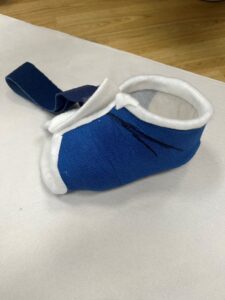Looking after your cast
Looking after your cast
 Your podiatrist will dress your foot wound with a primary and secondary dressing, followed by a protective layer and then a cast. A retention dressing is applied to hold the cast securely in place so it is in close contact with the whole surface of your foot. It is important that this close contact is maintained so that pressure is reduced at the site of your wound.
Your podiatrist will dress your foot wound with a primary and secondary dressing, followed by a protective layer and then a cast. A retention dressing is applied to hold the cast securely in place so it is in close contact with the whole surface of your foot. It is important that this close contact is maintained so that pressure is reduced at the site of your wound.
Types of cast
There are three main types of cast our podiatry team may use to support your wound in healing:
- Slipper cast
- Heel cast
- Below the knee total contact cast
Keep your cast clean
Keep both the dressing and the cast clean, dry and in place and avoid getting the cast wet. Casts should never be put in the washing machine. If your cast becomes heavily soiled or smelly – please contact your podiatrist to arrange a review.
Wearing your cast
Wear the cast all the time or as much as possible (if it is removable), this will give your foot some protection if you do need to do essential walking (eg: around the house). Your cast is not designed to be an alternative to a shoe, so you still need to:
- rest your foot as much as possible
- avoid walking on the wound to give it the best chance of healing
- do some gentle exercises such as flexing, pointing and wiggling the toes and rotating the ankle (if the cast allows for this)
- avoid driving whilst wearing your cast – seek advice on this as it may invalidate your insurance.
Using a leg protector to keep your dressing dry when showering or bathing
A leg protector can help to keep your dressing and cast dry when you need to shower or bathe. There are a variety of different brands, but Limbo and Seal Tight protectors are available on prescription. Here’s how to use them:
What to do if there’s a problem
If you experience sudden pain or swelling in the calf, seek urgent medical attention (contact your GP or ring 111 for advice) or attend Accident and Emergency.
If you experience any of the below please contact your local clinic:
- rubbing or marks from the cast
- swelling or changes to the normal oedema / swelling patterns
- redness or change in colour of the surrounding tissue
- increase in pain
- changes in pain sensation e.g., increase in numbness or pins and needles
- increase in the amount of fluid coming from the ulcer
- deteriorating smell to the wound
- increase in temperature around the wound
- hot or cold sweats or flu like symptoms develop
How to contact your local clinic
Our hospital and community clinics are open from 8.30am to 4.30 pm Monday to Friday. If you have a new foot wound, or a question about your current foot wound please contact us immediately on 01274 221165 or email Podiatry.enquiries@bdct.nhs.uk
